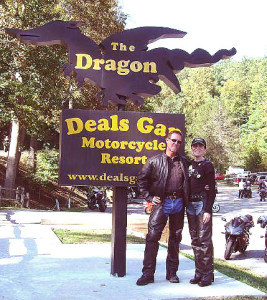Mastering the Curves – The Most Critical Factor
I’ve heard it said many times, “I’m not going to Deal’s Gap, that ‘Tail of the Dragon’ is too dangerous, I’m not experienced enough to handle the curves”. Truth be told, it takes more riding skill to navigate the crowded parking lot at the Deals Gap store than it does to ride the 318 curves in 11 miles that give the Dragon it’s toothy reputation.
The ability to carve through the curves on a motorcycle is a skill comprised of many complex factors. It takes experience. It takes practice. It takes familiarity and awareness of the capabilities and limitations of both the rider and the bike involved. Most of all it takes judgment. Of all the things that come into play, there is one critical factor that determines how everything else in a curve plays out – entry speed. Master that, and you master the curves.
So long as you come into a curve at a speed you’re comfortable with, lean angle, taking the correct line, throttle and brake control, weight shifting, all the other factors that can come into play are easy. So long as the speed is relaxed you will have ample room and time to adjust all the other factors and react to the unexpected. It is far better to hit a corner a little slow and accelerate through it than to come in too hot and fast, try to dump speed with the brakes, readjust your line, over-extend your lean, cross over the center line or worse.
Judging entry speed is the most important factor in riding the curves. The goal is to enter the curve at the speed that is optimal for your skills, maintain that speed through the apex of the turn, then accelerate out of the turn as the bike comes more upright.
It’s best to break the process of going through a curve up into parts so you focus on each of them independently. Judging the correct entry speed is the first step. Focus on it.
Evaluate the curve before you get to it estimating how tight it is and the speed at which you’ll feel comfortable handling it. Begin to adjust your speed with the brake or throttle before you start to tip the bike over for the lean. You should be done with braking before you begin the turn.
As you get closer to the curve scan the road and evaluate your entry point, the point at which you begin the line you plan to take through the curve. If your ideal spot has a pothole or a bump or there is loose gravel, you’ll need to change your line and adjust your speed even more. Be sure to give yourself time to make corrections not only for the hazards you see entering the curve, but in case something like loose gravel or a rock appears midway through it.
Position yourself so you can shift your weight quickly if needed. Get your feet on the pegs or floorboards and be aware if any movement of them will be needed to touch the brake. If you’re planning to shift your weight to the inside of the curve through the corner, go ahead and start before you get there. Be in a riding stance where you can adjust quickly if needed.
Once in the turn control the speed of the bike with the throttle. No throttle and the engine will continue to slow the bike. Steady throttle maintains your speed. Don’t get on the throttle until you have reached the apex and can see through the turn to know what’s around the bend.
Judging your entrance speed takes experience. The more you ride the curves, the better you will become a judging them. Even so you’ll occasionally get caught off guard, but if you always give yourself a margin for error, it will be there for you when you need it most. Remember to finish your braking before you get to the turn. Once you get this first step right, the ones that follow will come easy.
Wayne@americaridesmaps.com
>> Go To America Rides Maps.com – http://americaridesmaps.com/


